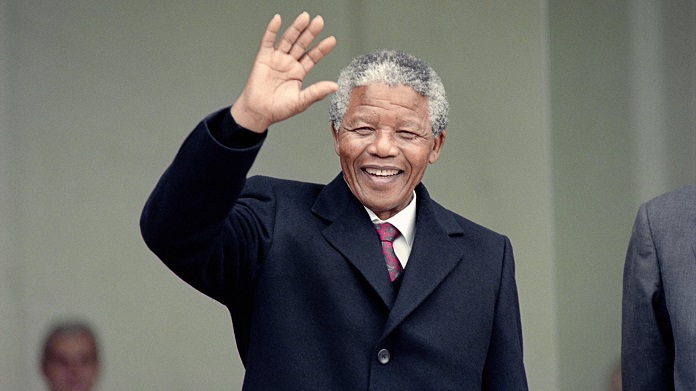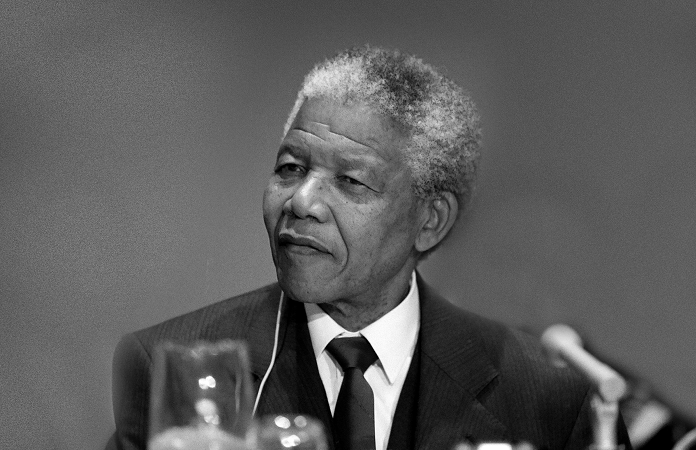Gibson Makanda is a fictional character in the Mandela Effect who the conspiracy theory alleges was used as a clone to hide the alleged death of Nelson Mandela in 1985. The theory gave birth to the Mandela Effect – a situation where a large group of people believe that an event occurred when it didn’t. In this case, many South African masses believe Nelson Mandela died in prison in 1985 and was replaced with a clone whose real name is Gibson Makanda.
Without information about his biography and background, Gibson Makanda’s history was mere speculation by conspiracy theorists. Some believed that he was an experienced actor, while others saw him as the Illuminati clone who came to impersonate Nelson Mandela.
Conspiracy theorists claimed that the apartheid regime brought him in to cover their track in the execution of the real Mandela and equally sell out their people to become the first black president in South Africa.
The Gibson Makanda Conspiracy Theory
A conspiracy theory once spread like wildfire about the late South African President Nelson Mandela. The theory propagated that Mandela died in the 80s and was replaced by a clone named Gibson Makanda.
The real Nelson Mandela was reported to have been killed in 1985, and his body was burnt in June by the oppressors of South African freedom.
According to the theorists, the whites who noticed that his death would bring about chaos decided to replace him with an imposter in prison to avoid raising suspicions amongst his comrades in Robben Island. They found this imposter in Gibson Makanda, who was cloned by supposed Illuminati doctors to look like the real Nelson Mandela.
They also gave him speech training to equally speak like him. Makanda, after being cloned as Mandela, was made to bargain with the apartheid government to become the first democratically elected black president.
Nelson Mandela’s family has since reacted to the conspiracy, calling it a farce. His late daughter Zindzi Mandela laughed it off on social media, calling the person who made reference to it a lunatic with a phone that has access to the media without the knowledge of his psychiatrist.
Facts That Supported The Conspiracy Theory
The Mandela effect and conspiracy theory came up after a group of people accepted that the South African freedom fighter died in prison in 1985. They used the following facts to support their claim.
1. The Inhumane Treatment Of South Africans
The inhuman treatment of South African protesters during that time at the hands of the military and paramilitary is the number one fact that has backed the conspiracy theory. It was recorded that the people of South Africa were been harassed with dogs, tear gas, guns, and other weapons to intimidate them and Nelson Mandela might have been killed and replaced with a clone.
2. He Sold-out His People After His Release
Nelson Mandela was a radical man before going to prison, but he immediately sold off South Africa to become the president on his release. As it was claimed, his policies when he went into power weren’t reflecting his zeal for the freedom of the country which caused his imprisonment, rather it brought more harm. This made some South Africans conclude that he had bigger plans, while some said that his stay in prison has broken him to become soft while some strongly believed that he is Gibson Makanda, sent with a mission because the real Nelson wouldn’t sell out his people and country.
3. The Speech and Divorce Of Winnie Mandela
Winnie Mandela‘s speech after her husband’s release also got the conspiracy theorists going. She stated that her husband went to prison a burning man but came back a different man from whom she knew.
Another claim stated that Winnie divorced Nelson Mandela immediately after his release from prison. On the claim, they stated that she must have found out that his clone returned and not him, which led to the divorce.
4. Celebration of 67 Minutes Of Charity
The celebration of the sixty-seven minutes of charity by South Africans is another claim that portrays the conspiracy theory. On the 18th of July every year, 67 minutes out of the day is taken out to impact the lives of others. Note that Nelson Mandela was born on the 18th of July, 1918. If, indeed, he died in Robben Island in 1985, he would have been 67 years old.
5. His Inability To Speak Xhosa
Nelson Mandela, who was born into the Thembu royal family and grew up with his tribesmen, regarded his culture and always spoke Xhosa. Another claim which was centered on this, stated that he stopped speaking isiXhosa from 1994 to his death. This, however was a huge concern for the people of South Africa.
6. The Mole On His Face
A claim on the position of a mole on the face of the ex-president was still used as a shred of evidence. Two pictures of the ex-president were shown on social media; one was of his younger age, and the other his old age. This pointed out the different positioning of the mole on his face, leading to the claim that they are basically not the same person.
7. The Phone Face App
The most recent claim was done with the Android face app. This app twists the face to show what it would probably look like either at a younger or old age. A young picture of the ex-president was used, and it showed a totally different age at old age and gave rise to reactions from South African Twitter users.
The Effect Of The Conspiracy Theory On South Africans
The Mandela Effect is the development of false information in the mind of South Africans who thought that they had an accurate recall of what happened in the past. This, however played in the mind of many citizens giving them the notion that they were accurate. Some said that they remembered his funeral, the chaos that came up, and the speech of Mandela’s widow.
With the facts that hoarded up in the mind of the theorists, they claimed that Nelson Mandela couldn’t have made it back if not the cloning. The name “Mandela Effect” was coined after a large number of people believed that he died in the 80s, despite not being true.
ANC’s Reactions To Mandela Effect and Conspiracy Theory
Nelson Mandela was a member of the ANC while fighting against the discrimination of blacks in South Africa. He also formed the ANC Youth League. The ANC has been with the late Nelson Mandela from the day of his activism to his death. They, however, did not react to the Mandela Effect and conspiracy theory, which states that he died in the 80s and was a clone. This silence has not been confirmed to put the theorists to rest, as they might come up with another fact tomorrow.


